Leadership Reflection Report: MBA Executive Leadership Analysis
VerifiedAdded on 2022/11/28
|12
|3511
|213
Report
AI Summary
This report presents a reflection on the author's leadership journey, encompassing experiences in the automotive industry across various roles, including technician, sales, and management positions. It explores three key aspects of leadership: leadership styles (authoritarian, participative, and laissez-faire), team leadership, and transformational leadership. The report provides a detailed analysis of each style, drawing on personal experiences to illustrate their practical application and impact. It examines the dynamics of team leadership, highlighting the responsibilities and qualities of effective team leaders. Furthermore, the report delves into transformational leadership, identifying its characteristics and the factors that contribute to its effectiveness, particularly in motivating employees and fostering a sense of collective identity. The author recommends improvements for future leadership roles and the report concludes with a leadership development plan based on the combined analysis of the previous chapter. This report provides valuable insights into the evolution of leadership skills and offers practical recommendations for aspiring leaders in the business context.

Running head: LEADERSHIP REFLECTION
LEADERSHIP REFLECTION
Name of the Student:
Name of the University:
Author Note:
LEADERSHIP REFLECTION
Name of the Student:
Name of the University:
Author Note:
Paraphrase This Document
Need a fresh take? Get an instant paraphrase of this document with our AI Paraphraser
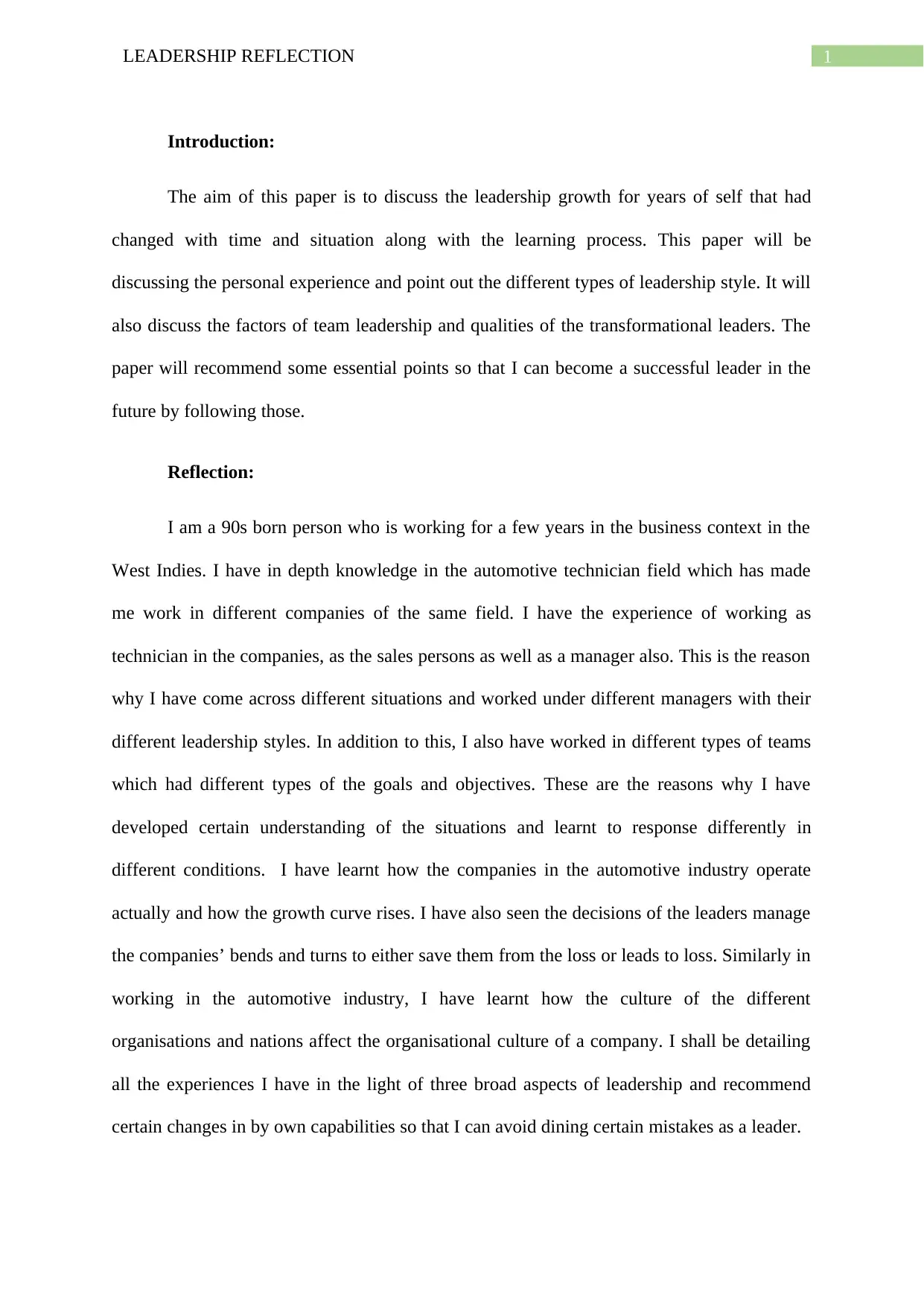
1LEADERSHIP REFLECTION
Introduction:
The aim of this paper is to discuss the leadership growth for years of self that had
changed with time and situation along with the learning process. This paper will be
discussing the personal experience and point out the different types of leadership style. It will
also discuss the factors of team leadership and qualities of the transformational leaders. The
paper will recommend some essential points so that I can become a successful leader in the
future by following those.
Reflection:
I am a 90s born person who is working for a few years in the business context in the
West Indies. I have in depth knowledge in the automotive technician field which has made
me work in different companies of the same field. I have the experience of working as
technician in the companies, as the sales persons as well as a manager also. This is the reason
why I have come across different situations and worked under different managers with their
different leadership styles. In addition to this, I also have worked in different types of teams
which had different types of the goals and objectives. These are the reasons why I have
developed certain understanding of the situations and learnt to response differently in
different conditions. I have learnt how the companies in the automotive industry operate
actually and how the growth curve rises. I have also seen the decisions of the leaders manage
the companies’ bends and turns to either save them from the loss or leads to loss. Similarly in
working in the automotive industry, I have learnt how the culture of the different
organisations and nations affect the organisational culture of a company. I shall be detailing
all the experiences I have in the light of three broad aspects of leadership and recommend
certain changes in by own capabilities so that I can avoid dining certain mistakes as a leader.
Introduction:
The aim of this paper is to discuss the leadership growth for years of self that had
changed with time and situation along with the learning process. This paper will be
discussing the personal experience and point out the different types of leadership style. It will
also discuss the factors of team leadership and qualities of the transformational leaders. The
paper will recommend some essential points so that I can become a successful leader in the
future by following those.
Reflection:
I am a 90s born person who is working for a few years in the business context in the
West Indies. I have in depth knowledge in the automotive technician field which has made
me work in different companies of the same field. I have the experience of working as
technician in the companies, as the sales persons as well as a manager also. This is the reason
why I have come across different situations and worked under different managers with their
different leadership styles. In addition to this, I also have worked in different types of teams
which had different types of the goals and objectives. These are the reasons why I have
developed certain understanding of the situations and learnt to response differently in
different conditions. I have learnt how the companies in the automotive industry operate
actually and how the growth curve rises. I have also seen the decisions of the leaders manage
the companies’ bends and turns to either save them from the loss or leads to loss. Similarly in
working in the automotive industry, I have learnt how the culture of the different
organisations and nations affect the organisational culture of a company. I shall be detailing
all the experiences I have in the light of three broad aspects of leadership and recommend
certain changes in by own capabilities so that I can avoid dining certain mistakes as a leader.
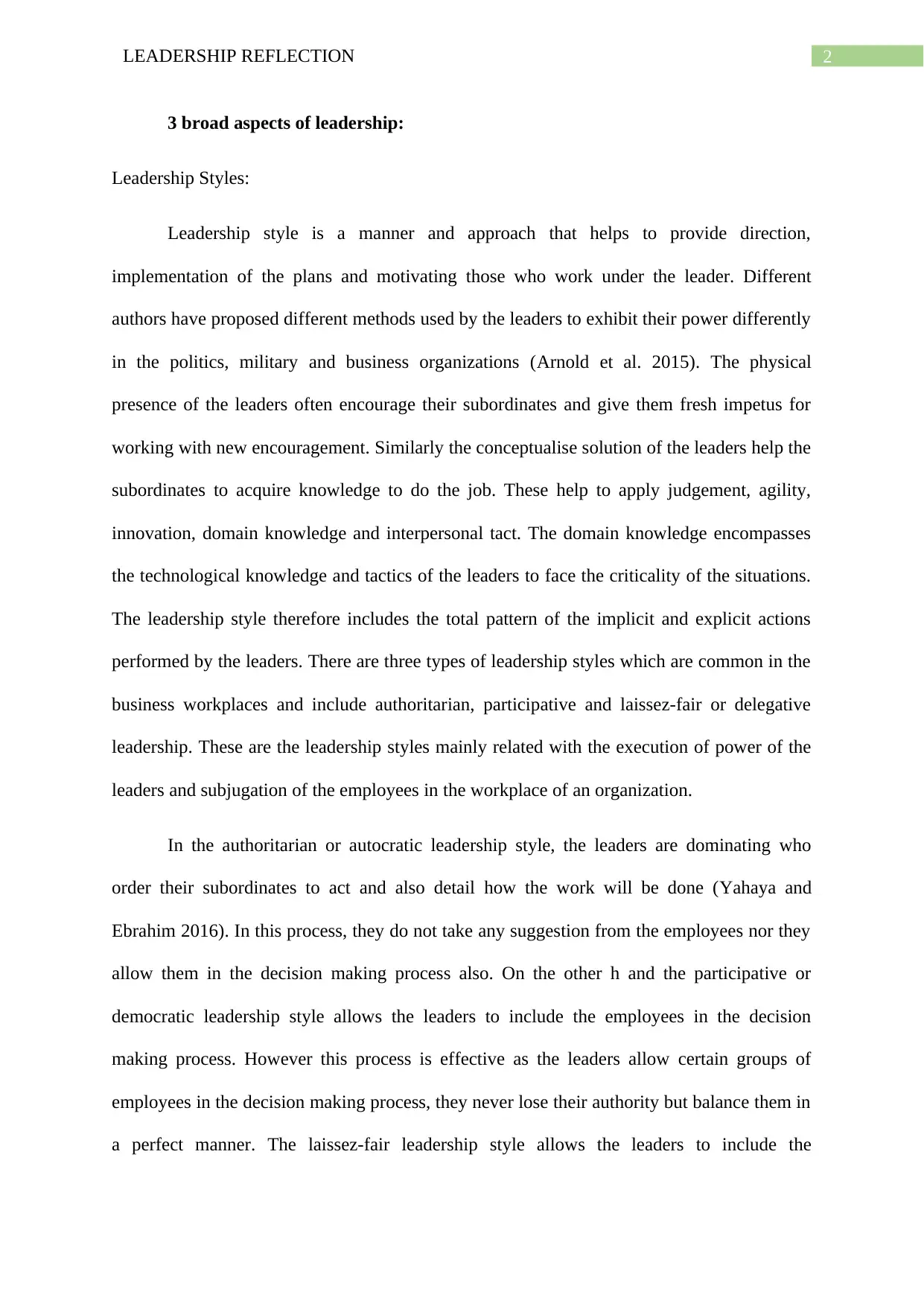
2LEADERSHIP REFLECTION
3 broad aspects of leadership:
Leadership Styles:
Leadership style is a manner and approach that helps to provide direction,
implementation of the plans and motivating those who work under the leader. Different
authors have proposed different methods used by the leaders to exhibit their power differently
in the politics, military and business organizations (Arnold et al. 2015). The physical
presence of the leaders often encourage their subordinates and give them fresh impetus for
working with new encouragement. Similarly the conceptualise solution of the leaders help the
subordinates to acquire knowledge to do the job. These help to apply judgement, agility,
innovation, domain knowledge and interpersonal tact. The domain knowledge encompasses
the technological knowledge and tactics of the leaders to face the criticality of the situations.
The leadership style therefore includes the total pattern of the implicit and explicit actions
performed by the leaders. There are three types of leadership styles which are common in the
business workplaces and include authoritarian, participative and laissez-fair or delegative
leadership. These are the leadership styles mainly related with the execution of power of the
leaders and subjugation of the employees in the workplace of an organization.
In the authoritarian or autocratic leadership style, the leaders are dominating who
order their subordinates to act and also detail how the work will be done (Yahaya and
Ebrahim 2016). In this process, they do not take any suggestion from the employees nor they
allow them in the decision making process also. On the other h and the participative or
democratic leadership style allows the leaders to include the employees in the decision
making process. However this process is effective as the leaders allow certain groups of
employees in the decision making process, they never lose their authority but balance them in
a perfect manner. The laissez-fair leadership style allows the leaders to include the
3 broad aspects of leadership:
Leadership Styles:
Leadership style is a manner and approach that helps to provide direction,
implementation of the plans and motivating those who work under the leader. Different
authors have proposed different methods used by the leaders to exhibit their power differently
in the politics, military and business organizations (Arnold et al. 2015). The physical
presence of the leaders often encourage their subordinates and give them fresh impetus for
working with new encouragement. Similarly the conceptualise solution of the leaders help the
subordinates to acquire knowledge to do the job. These help to apply judgement, agility,
innovation, domain knowledge and interpersonal tact. The domain knowledge encompasses
the technological knowledge and tactics of the leaders to face the criticality of the situations.
The leadership style therefore includes the total pattern of the implicit and explicit actions
performed by the leaders. There are three types of leadership styles which are common in the
business workplaces and include authoritarian, participative and laissez-fair or delegative
leadership. These are the leadership styles mainly related with the execution of power of the
leaders and subjugation of the employees in the workplace of an organization.
In the authoritarian or autocratic leadership style, the leaders are dominating who
order their subordinates to act and also detail how the work will be done (Yahaya and
Ebrahim 2016). In this process, they do not take any suggestion from the employees nor they
allow them in the decision making process also. On the other h and the participative or
democratic leadership style allows the leaders to include the employees in the decision
making process. However this process is effective as the leaders allow certain groups of
employees in the decision making process, they never lose their authority but balance them in
a perfect manner. The laissez-fair leadership style allows the leaders to include the
⊘ This is a preview!⊘
Do you want full access?
Subscribe today to unlock all pages.

Trusted by 1+ million students worldwide
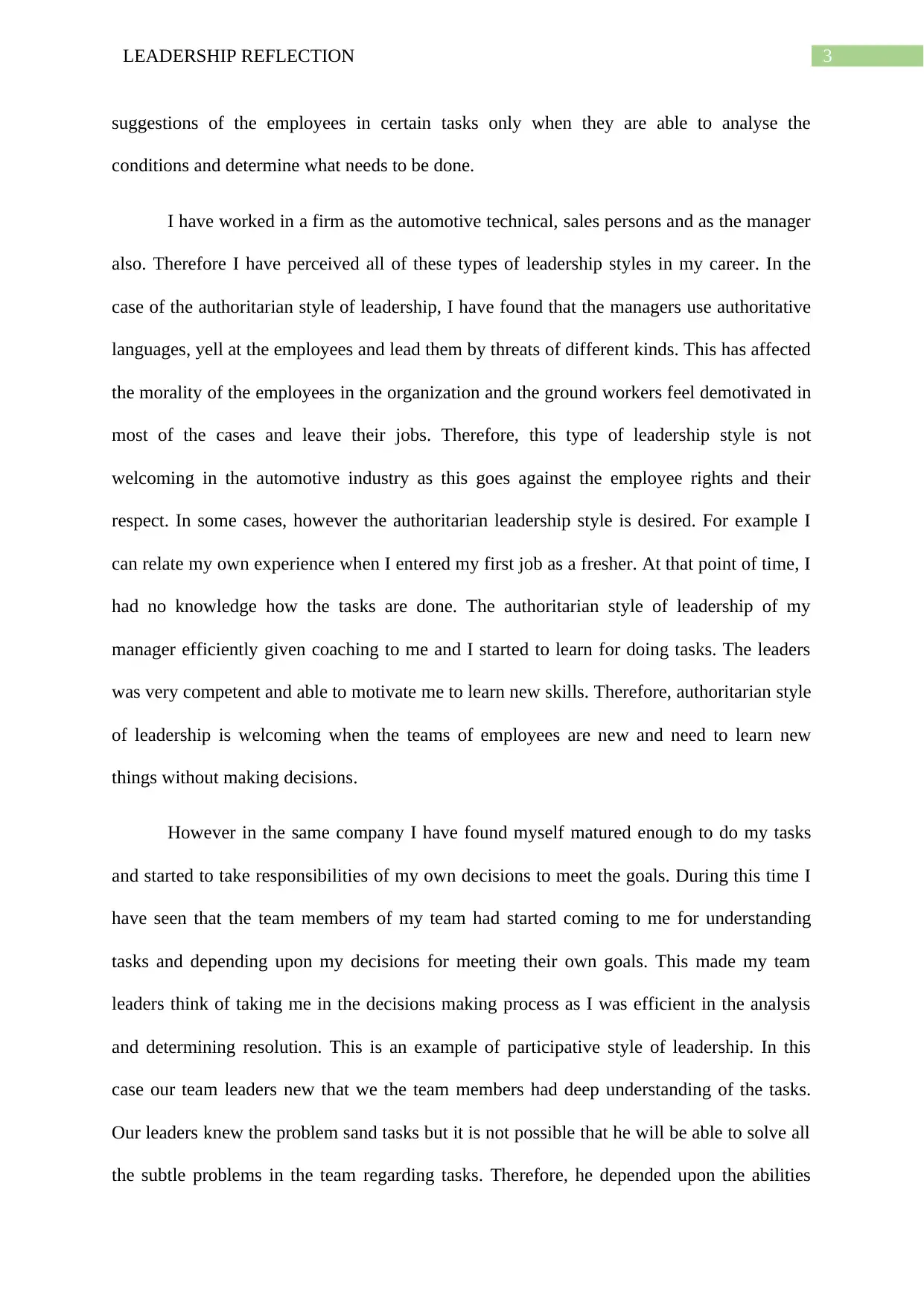
3LEADERSHIP REFLECTION
suggestions of the employees in certain tasks only when they are able to analyse the
conditions and determine what needs to be done.
I have worked in a firm as the automotive technical, sales persons and as the manager
also. Therefore I have perceived all of these types of leadership styles in my career. In the
case of the authoritarian style of leadership, I have found that the managers use authoritative
languages, yell at the employees and lead them by threats of different kinds. This has affected
the morality of the employees in the organization and the ground workers feel demotivated in
most of the cases and leave their jobs. Therefore, this type of leadership style is not
welcoming in the automotive industry as this goes against the employee rights and their
respect. In some cases, however the authoritarian leadership style is desired. For example I
can relate my own experience when I entered my first job as a fresher. At that point of time, I
had no knowledge how the tasks are done. The authoritarian style of leadership of my
manager efficiently given coaching to me and I started to learn for doing tasks. The leaders
was very competent and able to motivate me to learn new skills. Therefore, authoritarian style
of leadership is welcoming when the teams of employees are new and need to learn new
things without making decisions.
However in the same company I have found myself matured enough to do my tasks
and started to take responsibilities of my own decisions to meet the goals. During this time I
have seen that the team members of my team had started coming to me for understanding
tasks and depending upon my decisions for meeting their own goals. This made my team
leaders think of taking me in the decisions making process as I was efficient in the analysis
and determining resolution. This is an example of participative style of leadership. In this
case our team leaders new that we the team members had deep understanding of the tasks.
Our leaders knew the problem sand tasks but it is not possible that he will be able to solve all
the subtle problems in the team regarding tasks. Therefore, he depended upon the abilities
suggestions of the employees in certain tasks only when they are able to analyse the
conditions and determine what needs to be done.
I have worked in a firm as the automotive technical, sales persons and as the manager
also. Therefore I have perceived all of these types of leadership styles in my career. In the
case of the authoritarian style of leadership, I have found that the managers use authoritative
languages, yell at the employees and lead them by threats of different kinds. This has affected
the morality of the employees in the organization and the ground workers feel demotivated in
most of the cases and leave their jobs. Therefore, this type of leadership style is not
welcoming in the automotive industry as this goes against the employee rights and their
respect. In some cases, however the authoritarian leadership style is desired. For example I
can relate my own experience when I entered my first job as a fresher. At that point of time, I
had no knowledge how the tasks are done. The authoritarian style of leadership of my
manager efficiently given coaching to me and I started to learn for doing tasks. The leaders
was very competent and able to motivate me to learn new skills. Therefore, authoritarian style
of leadership is welcoming when the teams of employees are new and need to learn new
things without making decisions.
However in the same company I have found myself matured enough to do my tasks
and started to take responsibilities of my own decisions to meet the goals. During this time I
have seen that the team members of my team had started coming to me for understanding
tasks and depending upon my decisions for meeting their own goals. This made my team
leaders think of taking me in the decisions making process as I was efficient in the analysis
and determining resolution. This is an example of participative style of leadership. In this
case our team leaders new that we the team members had deep understanding of the tasks.
Our leaders knew the problem sand tasks but it is not possible that he will be able to solve all
the subtle problems in the team regarding tasks. Therefore, he depended upon the abilities
Paraphrase This Document
Need a fresh take? Get an instant paraphrase of this document with our AI Paraphraser
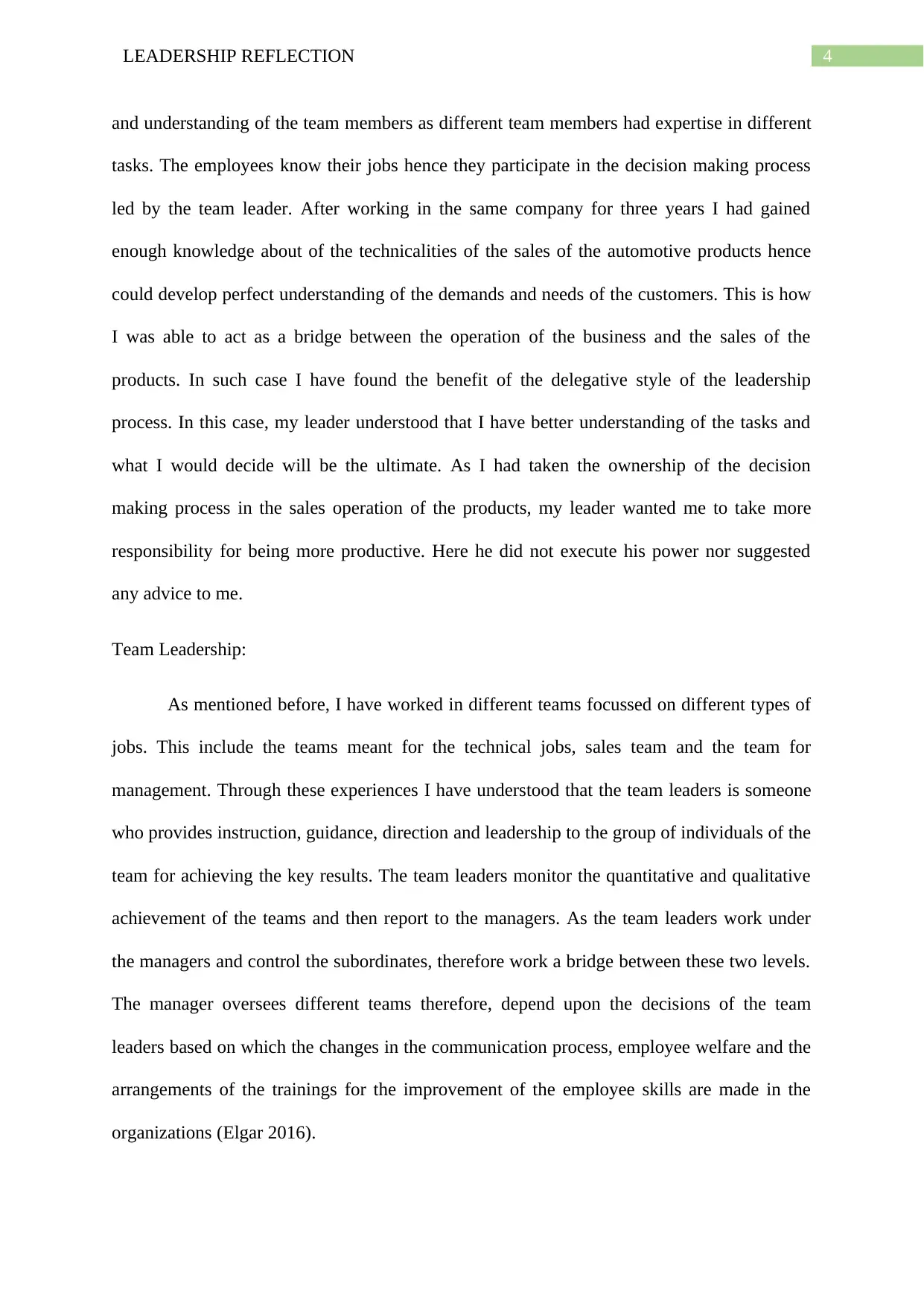
4LEADERSHIP REFLECTION
and understanding of the team members as different team members had expertise in different
tasks. The employees know their jobs hence they participate in the decision making process
led by the team leader. After working in the same company for three years I had gained
enough knowledge about of the technicalities of the sales of the automotive products hence
could develop perfect understanding of the demands and needs of the customers. This is how
I was able to act as a bridge between the operation of the business and the sales of the
products. In such case I have found the benefit of the delegative style of the leadership
process. In this case, my leader understood that I have better understanding of the tasks and
what I would decide will be the ultimate. As I had taken the ownership of the decision
making process in the sales operation of the products, my leader wanted me to take more
responsibility for being more productive. Here he did not execute his power nor suggested
any advice to me.
Team Leadership:
As mentioned before, I have worked in different teams focussed on different types of
jobs. This include the teams meant for the technical jobs, sales team and the team for
management. Through these experiences I have understood that the team leaders is someone
who provides instruction, guidance, direction and leadership to the group of individuals of the
team for achieving the key results. The team leaders monitor the quantitative and qualitative
achievement of the teams and then report to the managers. As the team leaders work under
the managers and control the subordinates, therefore work a bridge between these two levels.
The manager oversees different teams therefore, depend upon the decisions of the team
leaders based on which the changes in the communication process, employee welfare and the
arrangements of the trainings for the improvement of the employee skills are made in the
organizations (Elgar 2016).
and understanding of the team members as different team members had expertise in different
tasks. The employees know their jobs hence they participate in the decision making process
led by the team leader. After working in the same company for three years I had gained
enough knowledge about of the technicalities of the sales of the automotive products hence
could develop perfect understanding of the demands and needs of the customers. This is how
I was able to act as a bridge between the operation of the business and the sales of the
products. In such case I have found the benefit of the delegative style of the leadership
process. In this case, my leader understood that I have better understanding of the tasks and
what I would decide will be the ultimate. As I had taken the ownership of the decision
making process in the sales operation of the products, my leader wanted me to take more
responsibility for being more productive. Here he did not execute his power nor suggested
any advice to me.
Team Leadership:
As mentioned before, I have worked in different teams focussed on different types of
jobs. This include the teams meant for the technical jobs, sales team and the team for
management. Through these experiences I have understood that the team leaders is someone
who provides instruction, guidance, direction and leadership to the group of individuals of the
team for achieving the key results. The team leaders monitor the quantitative and qualitative
achievement of the teams and then report to the managers. As the team leaders work under
the managers and control the subordinates, therefore work a bridge between these two levels.
The manager oversees different teams therefore, depend upon the decisions of the team
leaders based on which the changes in the communication process, employee welfare and the
arrangements of the trainings for the improvement of the employee skills are made in the
organizations (Elgar 2016).
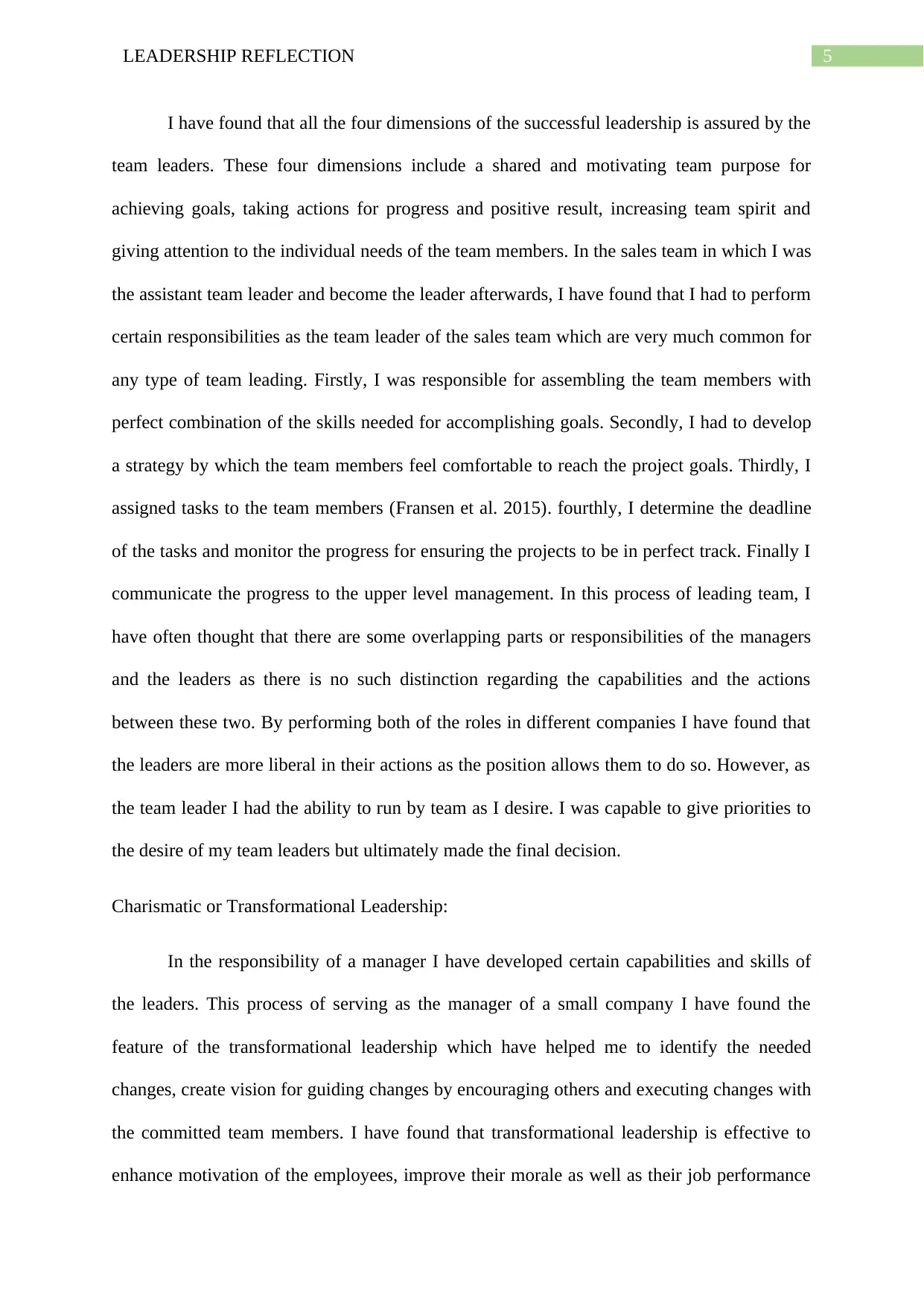
5LEADERSHIP REFLECTION
I have found that all the four dimensions of the successful leadership is assured by the
team leaders. These four dimensions include a shared and motivating team purpose for
achieving goals, taking actions for progress and positive result, increasing team spirit and
giving attention to the individual needs of the team members. In the sales team in which I was
the assistant team leader and become the leader afterwards, I have found that I had to perform
certain responsibilities as the team leader of the sales team which are very much common for
any type of team leading. Firstly, I was responsible for assembling the team members with
perfect combination of the skills needed for accomplishing goals. Secondly, I had to develop
a strategy by which the team members feel comfortable to reach the project goals. Thirdly, I
assigned tasks to the team members (Fransen et al. 2015). fourthly, I determine the deadline
of the tasks and monitor the progress for ensuring the projects to be in perfect track. Finally I
communicate the progress to the upper level management. In this process of leading team, I
have often thought that there are some overlapping parts or responsibilities of the managers
and the leaders as there is no such distinction regarding the capabilities and the actions
between these two. By performing both of the roles in different companies I have found that
the leaders are more liberal in their actions as the position allows them to do so. However, as
the team leader I had the ability to run by team as I desire. I was capable to give priorities to
the desire of my team leaders but ultimately made the final decision.
Charismatic or Transformational Leadership:
In the responsibility of a manager I have developed certain capabilities and skills of
the leaders. This process of serving as the manager of a small company I have found the
feature of the transformational leadership which have helped me to identify the needed
changes, create vision for guiding changes by encouraging others and executing changes with
the committed team members. I have found that transformational leadership is effective to
enhance motivation of the employees, improve their morale as well as their job performance
I have found that all the four dimensions of the successful leadership is assured by the
team leaders. These four dimensions include a shared and motivating team purpose for
achieving goals, taking actions for progress and positive result, increasing team spirit and
giving attention to the individual needs of the team members. In the sales team in which I was
the assistant team leader and become the leader afterwards, I have found that I had to perform
certain responsibilities as the team leader of the sales team which are very much common for
any type of team leading. Firstly, I was responsible for assembling the team members with
perfect combination of the skills needed for accomplishing goals. Secondly, I had to develop
a strategy by which the team members feel comfortable to reach the project goals. Thirdly, I
assigned tasks to the team members (Fransen et al. 2015). fourthly, I determine the deadline
of the tasks and monitor the progress for ensuring the projects to be in perfect track. Finally I
communicate the progress to the upper level management. In this process of leading team, I
have often thought that there are some overlapping parts or responsibilities of the managers
and the leaders as there is no such distinction regarding the capabilities and the actions
between these two. By performing both of the roles in different companies I have found that
the leaders are more liberal in their actions as the position allows them to do so. However, as
the team leader I had the ability to run by team as I desire. I was capable to give priorities to
the desire of my team leaders but ultimately made the final decision.
Charismatic or Transformational Leadership:
In the responsibility of a manager I have developed certain capabilities and skills of
the leaders. This process of serving as the manager of a small company I have found the
feature of the transformational leadership which have helped me to identify the needed
changes, create vision for guiding changes by encouraging others and executing changes with
the committed team members. I have found that transformational leadership is effective to
enhance motivation of the employees, improve their morale as well as their job performance
⊘ This is a preview!⊘
Do you want full access?
Subscribe today to unlock all pages.

Trusted by 1+ million students worldwide
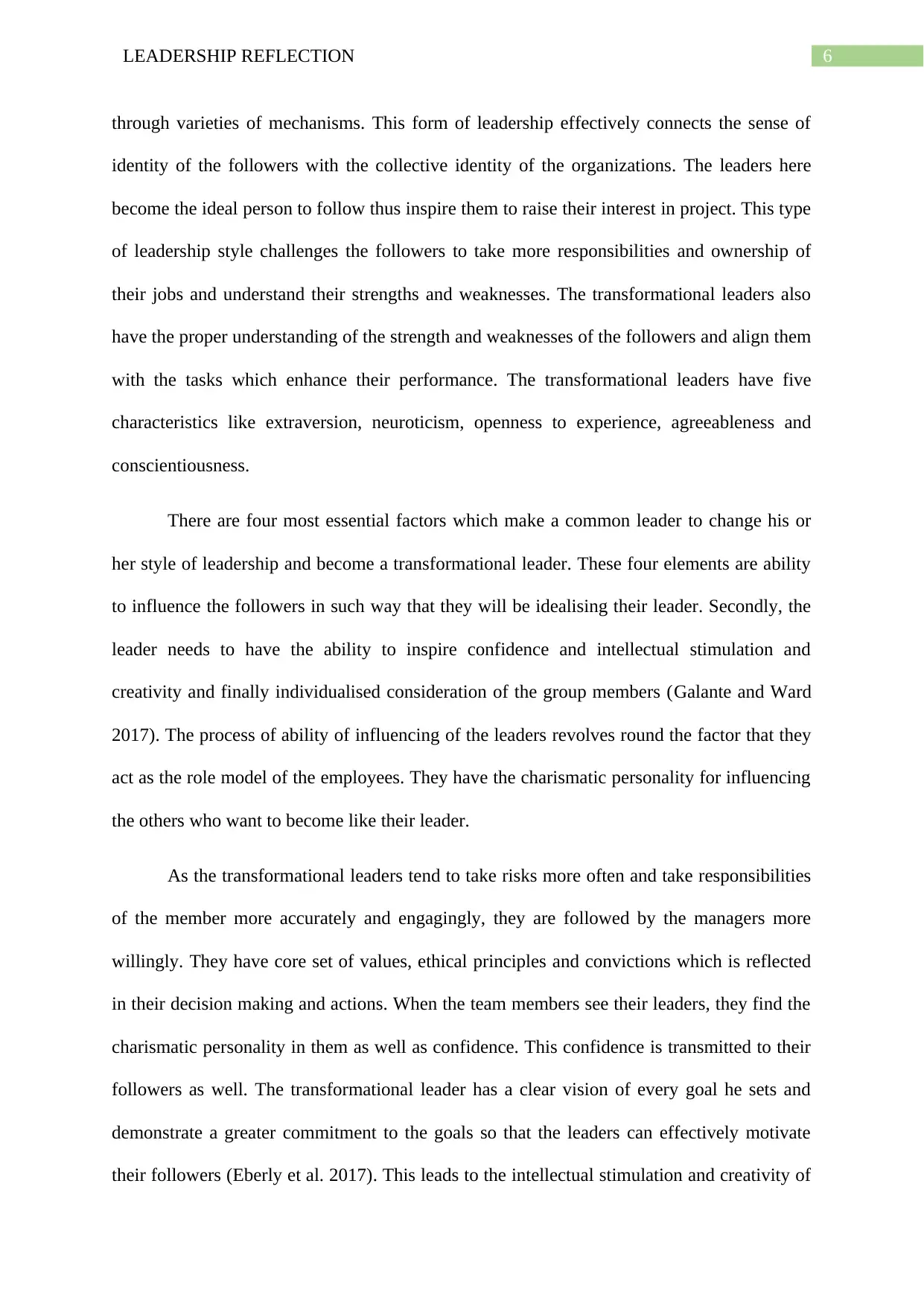
6LEADERSHIP REFLECTION
through varieties of mechanisms. This form of leadership effectively connects the sense of
identity of the followers with the collective identity of the organizations. The leaders here
become the ideal person to follow thus inspire them to raise their interest in project. This type
of leadership style challenges the followers to take more responsibilities and ownership of
their jobs and understand their strengths and weaknesses. The transformational leaders also
have the proper understanding of the strength and weaknesses of the followers and align them
with the tasks which enhance their performance. The transformational leaders have five
characteristics like extraversion, neuroticism, openness to experience, agreeableness and
conscientiousness.
There are four most essential factors which make a common leader to change his or
her style of leadership and become a transformational leader. These four elements are ability
to influence the followers in such way that they will be idealising their leader. Secondly, the
leader needs to have the ability to inspire confidence and intellectual stimulation and
creativity and finally individualised consideration of the group members (Galante and Ward
2017). The process of ability of influencing of the leaders revolves round the factor that they
act as the role model of the employees. They have the charismatic personality for influencing
the others who want to become like their leader.
As the transformational leaders tend to take risks more often and take responsibilities
of the member more accurately and engagingly, they are followed by the managers more
willingly. They have core set of values, ethical principles and convictions which is reflected
in their decision making and actions. When the team members see their leaders, they find the
charismatic personality in them as well as confidence. This confidence is transmitted to their
followers as well. The transformational leader has a clear vision of every goal he sets and
demonstrate a greater commitment to the goals so that the leaders can effectively motivate
their followers (Eberly et al. 2017). This leads to the intellectual stimulation and creativity of
through varieties of mechanisms. This form of leadership effectively connects the sense of
identity of the followers with the collective identity of the organizations. The leaders here
become the ideal person to follow thus inspire them to raise their interest in project. This type
of leadership style challenges the followers to take more responsibilities and ownership of
their jobs and understand their strengths and weaknesses. The transformational leaders also
have the proper understanding of the strength and weaknesses of the followers and align them
with the tasks which enhance their performance. The transformational leaders have five
characteristics like extraversion, neuroticism, openness to experience, agreeableness and
conscientiousness.
There are four most essential factors which make a common leader to change his or
her style of leadership and become a transformational leader. These four elements are ability
to influence the followers in such way that they will be idealising their leader. Secondly, the
leader needs to have the ability to inspire confidence and intellectual stimulation and
creativity and finally individualised consideration of the group members (Galante and Ward
2017). The process of ability of influencing of the leaders revolves round the factor that they
act as the role model of the employees. They have the charismatic personality for influencing
the others who want to become like their leader.
As the transformational leaders tend to take risks more often and take responsibilities
of the member more accurately and engagingly, they are followed by the managers more
willingly. They have core set of values, ethical principles and convictions which is reflected
in their decision making and actions. When the team members see their leaders, they find the
charismatic personality in them as well as confidence. This confidence is transmitted to their
followers as well. The transformational leader has a clear vision of every goal he sets and
demonstrate a greater commitment to the goals so that the leaders can effectively motivate
their followers (Eberly et al. 2017). This leads to the intellectual stimulation and creativity of
Paraphrase This Document
Need a fresh take? Get an instant paraphrase of this document with our AI Paraphraser
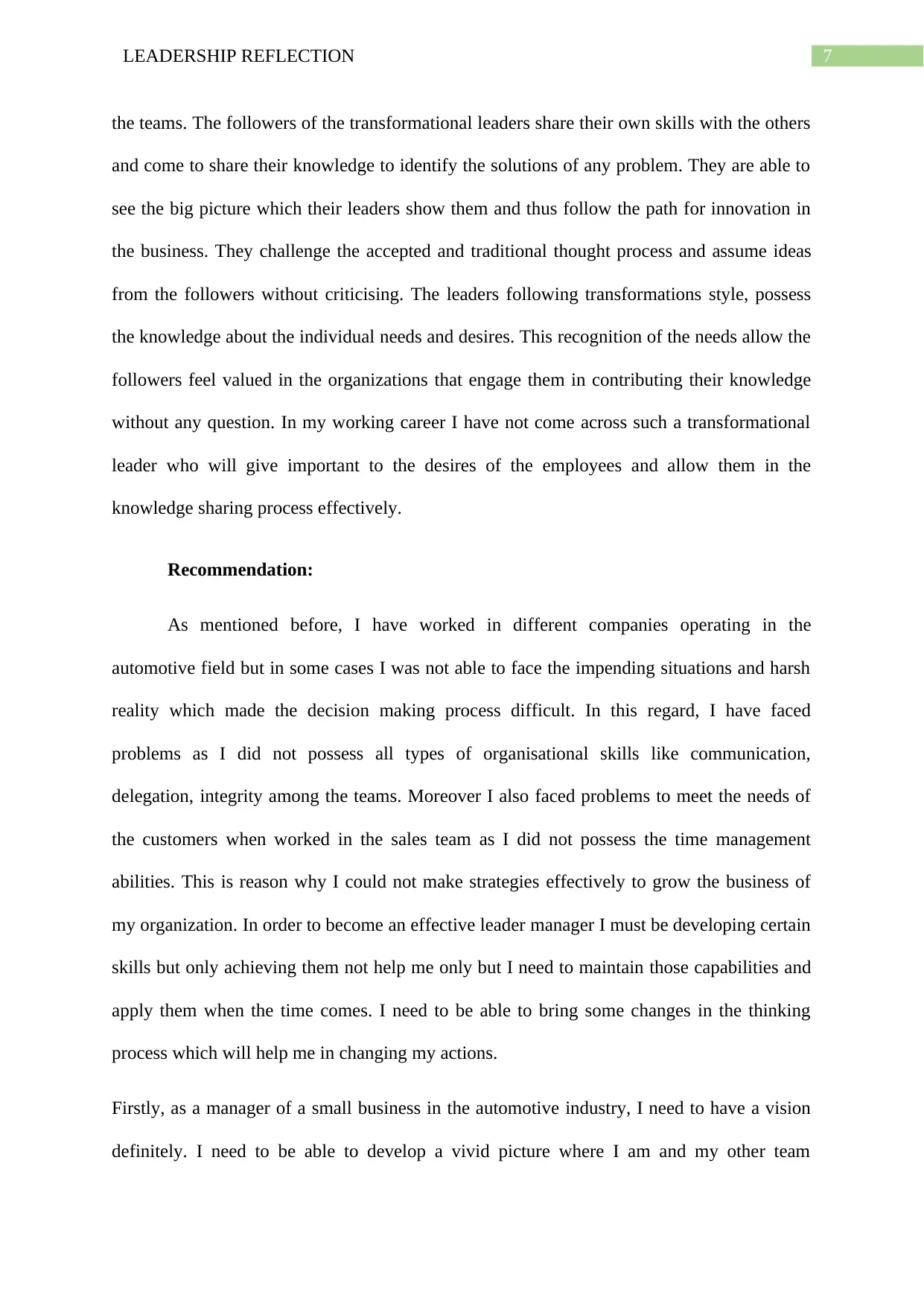
7LEADERSHIP REFLECTION
the teams. The followers of the transformational leaders share their own skills with the others
and come to share their knowledge to identify the solutions of any problem. They are able to
see the big picture which their leaders show them and thus follow the path for innovation in
the business. They challenge the accepted and traditional thought process and assume ideas
from the followers without criticising. The leaders following transformations style, possess
the knowledge about the individual needs and desires. This recognition of the needs allow the
followers feel valued in the organizations that engage them in contributing their knowledge
without any question. In my working career I have not come across such a transformational
leader who will give important to the desires of the employees and allow them in the
knowledge sharing process effectively.
Recommendation:
As mentioned before, I have worked in different companies operating in the
automotive field but in some cases I was not able to face the impending situations and harsh
reality which made the decision making process difficult. In this regard, I have faced
problems as I did not possess all types of organisational skills like communication,
delegation, integrity among the teams. Moreover I also faced problems to meet the needs of
the customers when worked in the sales team as I did not possess the time management
abilities. This is reason why I could not make strategies effectively to grow the business of
my organization. In order to become an effective leader manager I must be developing certain
skills but only achieving them not help me only but I need to maintain those capabilities and
apply them when the time comes. I need to be able to bring some changes in the thinking
process which will help me in changing my actions.
Firstly, as a manager of a small business in the automotive industry, I need to have a vision
definitely. I need to be able to develop a vivid picture where I am and my other team
the teams. The followers of the transformational leaders share their own skills with the others
and come to share their knowledge to identify the solutions of any problem. They are able to
see the big picture which their leaders show them and thus follow the path for innovation in
the business. They challenge the accepted and traditional thought process and assume ideas
from the followers without criticising. The leaders following transformations style, possess
the knowledge about the individual needs and desires. This recognition of the needs allow the
followers feel valued in the organizations that engage them in contributing their knowledge
without any question. In my working career I have not come across such a transformational
leader who will give important to the desires of the employees and allow them in the
knowledge sharing process effectively.
Recommendation:
As mentioned before, I have worked in different companies operating in the
automotive field but in some cases I was not able to face the impending situations and harsh
reality which made the decision making process difficult. In this regard, I have faced
problems as I did not possess all types of organisational skills like communication,
delegation, integrity among the teams. Moreover I also faced problems to meet the needs of
the customers when worked in the sales team as I did not possess the time management
abilities. This is reason why I could not make strategies effectively to grow the business of
my organization. In order to become an effective leader manager I must be developing certain
skills but only achieving them not help me only but I need to maintain those capabilities and
apply them when the time comes. I need to be able to bring some changes in the thinking
process which will help me in changing my actions.
Firstly, as a manager of a small business in the automotive industry, I need to have a vision
definitely. I need to be able to develop a vivid picture where I am and my other team
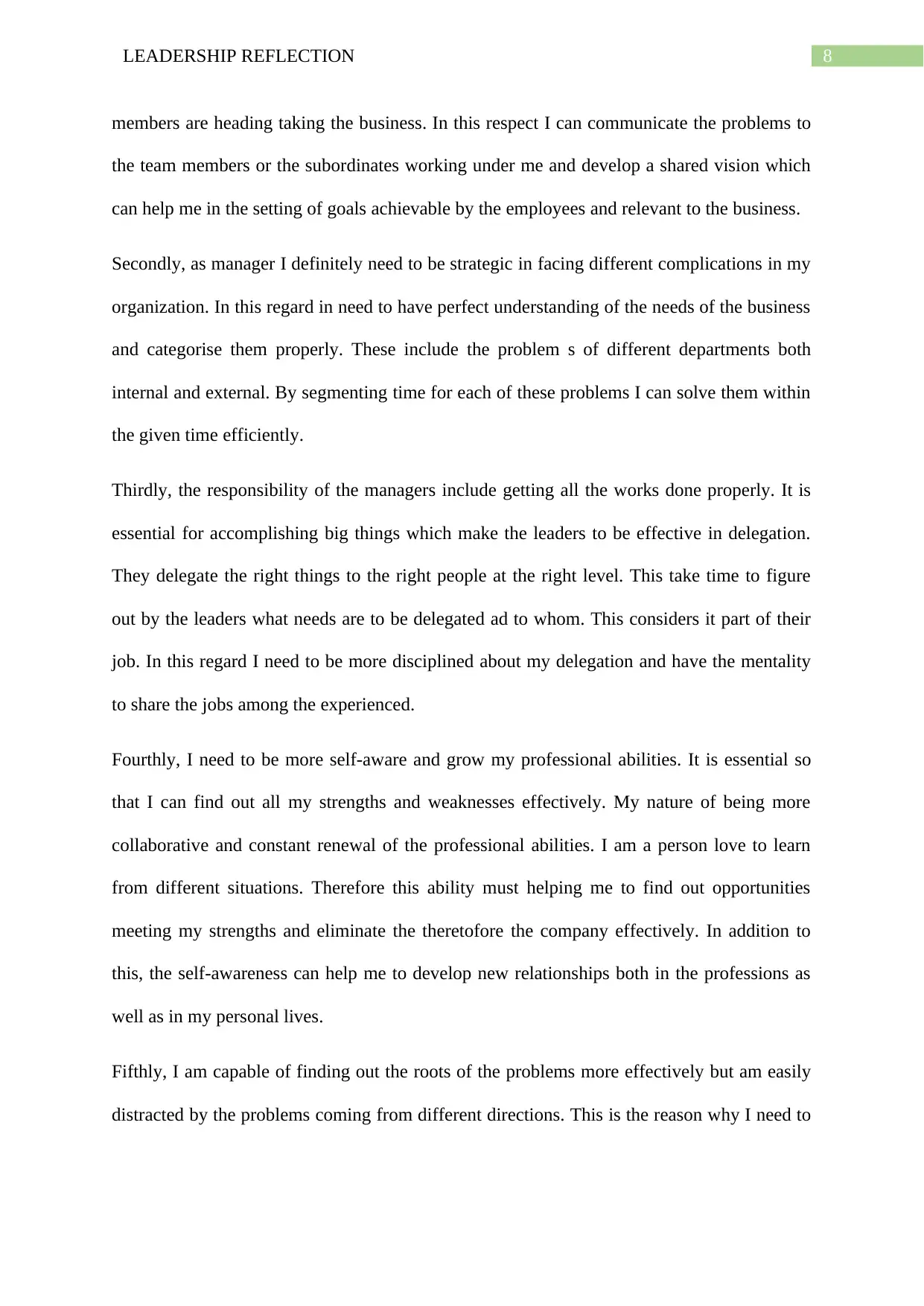
8LEADERSHIP REFLECTION
members are heading taking the business. In this respect I can communicate the problems to
the team members or the subordinates working under me and develop a shared vision which
can help me in the setting of goals achievable by the employees and relevant to the business.
Secondly, as manager I definitely need to be strategic in facing different complications in my
organization. In this regard in need to have perfect understanding of the needs of the business
and categorise them properly. These include the problem s of different departments both
internal and external. By segmenting time for each of these problems I can solve them within
the given time efficiently.
Thirdly, the responsibility of the managers include getting all the works done properly. It is
essential for accomplishing big things which make the leaders to be effective in delegation.
They delegate the right things to the right people at the right level. This take time to figure
out by the leaders what needs are to be delegated ad to whom. This considers it part of their
job. In this regard I need to be more disciplined about my delegation and have the mentality
to share the jobs among the experienced.
Fourthly, I need to be more self-aware and grow my professional abilities. It is essential so
that I can find out all my strengths and weaknesses effectively. My nature of being more
collaborative and constant renewal of the professional abilities. I am a person love to learn
from different situations. Therefore this ability must helping me to find out opportunities
meeting my strengths and eliminate the theretofore the company effectively. In addition to
this, the self-awareness can help me to develop new relationships both in the professions as
well as in my personal lives.
Fifthly, I am capable of finding out the roots of the problems more effectively but am easily
distracted by the problems coming from different directions. This is the reason why I need to
members are heading taking the business. In this respect I can communicate the problems to
the team members or the subordinates working under me and develop a shared vision which
can help me in the setting of goals achievable by the employees and relevant to the business.
Secondly, as manager I definitely need to be strategic in facing different complications in my
organization. In this regard in need to have perfect understanding of the needs of the business
and categorise them properly. These include the problem s of different departments both
internal and external. By segmenting time for each of these problems I can solve them within
the given time efficiently.
Thirdly, the responsibility of the managers include getting all the works done properly. It is
essential for accomplishing big things which make the leaders to be effective in delegation.
They delegate the right things to the right people at the right level. This take time to figure
out by the leaders what needs are to be delegated ad to whom. This considers it part of their
job. In this regard I need to be more disciplined about my delegation and have the mentality
to share the jobs among the experienced.
Fourthly, I need to be more self-aware and grow my professional abilities. It is essential so
that I can find out all my strengths and weaknesses effectively. My nature of being more
collaborative and constant renewal of the professional abilities. I am a person love to learn
from different situations. Therefore this ability must helping me to find out opportunities
meeting my strengths and eliminate the theretofore the company effectively. In addition to
this, the self-awareness can help me to develop new relationships both in the professions as
well as in my personal lives.
Fifthly, I am capable of finding out the roots of the problems more effectively but am easily
distracted by the problems coming from different directions. This is the reason why I need to
⊘ This is a preview!⊘
Do you want full access?
Subscribe today to unlock all pages.

Trusted by 1+ million students worldwide
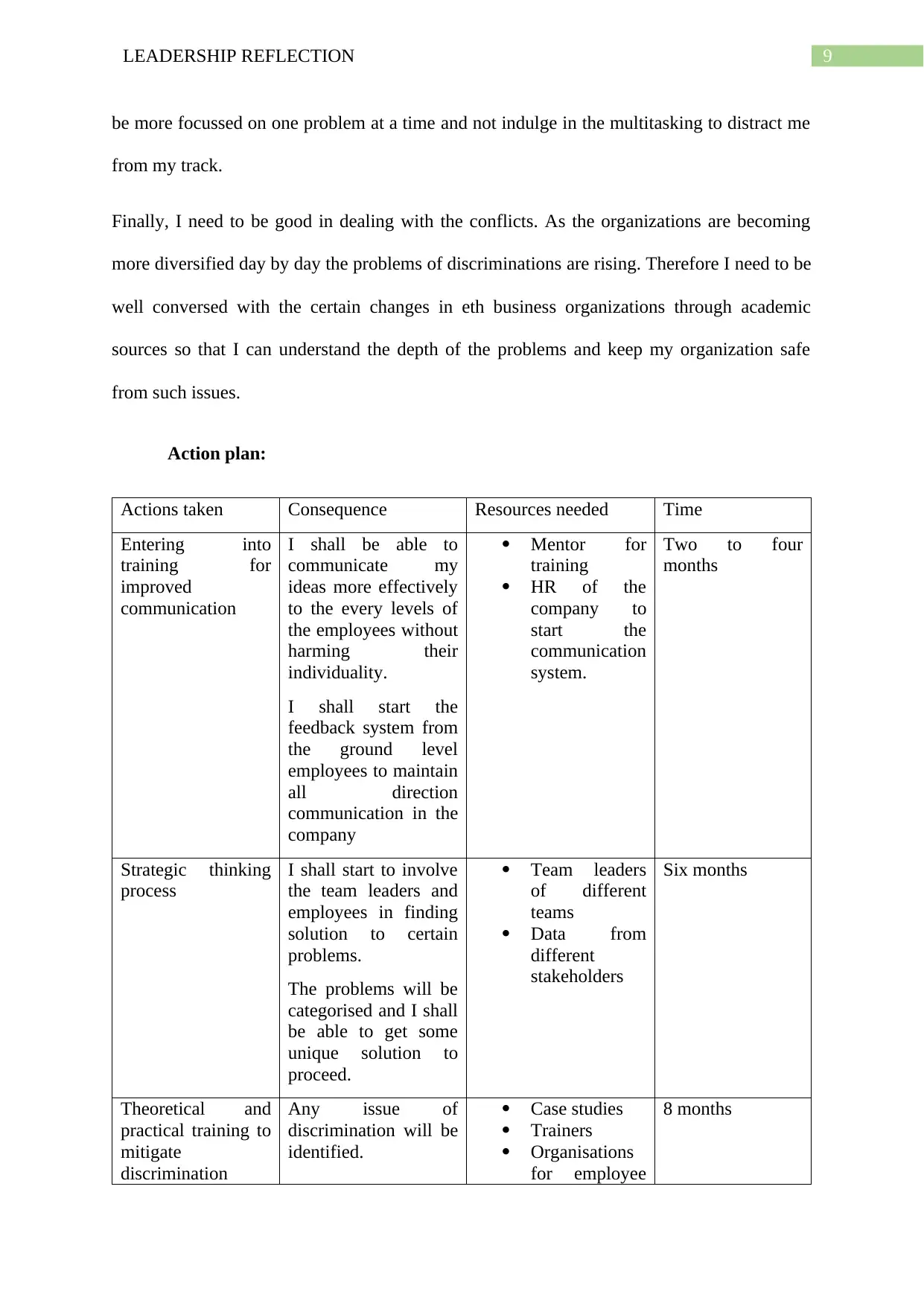
9LEADERSHIP REFLECTION
be more focussed on one problem at a time and not indulge in the multitasking to distract me
from my track.
Finally, I need to be good in dealing with the conflicts. As the organizations are becoming
more diversified day by day the problems of discriminations are rising. Therefore I need to be
well conversed with the certain changes in eth business organizations through academic
sources so that I can understand the depth of the problems and keep my organization safe
from such issues.
Action plan:
Actions taken Consequence Resources needed Time
Entering into
training for
improved
communication
I shall be able to
communicate my
ideas more effectively
to the every levels of
the employees without
harming their
individuality.
I shall start the
feedback system from
the ground level
employees to maintain
all direction
communication in the
company
Mentor for
training
HR of the
company to
start the
communication
system.
Two to four
months
Strategic thinking
process
I shall start to involve
the team leaders and
employees in finding
solution to certain
problems.
The problems will be
categorised and I shall
be able to get some
unique solution to
proceed.
Team leaders
of different
teams
Data from
different
stakeholders
Six months
Theoretical and
practical training to
mitigate
discrimination
Any issue of
discrimination will be
identified.
Case studies
Trainers
Organisations
for employee
8 months
be more focussed on one problem at a time and not indulge in the multitasking to distract me
from my track.
Finally, I need to be good in dealing with the conflicts. As the organizations are becoming
more diversified day by day the problems of discriminations are rising. Therefore I need to be
well conversed with the certain changes in eth business organizations through academic
sources so that I can understand the depth of the problems and keep my organization safe
from such issues.
Action plan:
Actions taken Consequence Resources needed Time
Entering into
training for
improved
communication
I shall be able to
communicate my
ideas more effectively
to the every levels of
the employees without
harming their
individuality.
I shall start the
feedback system from
the ground level
employees to maintain
all direction
communication in the
company
Mentor for
training
HR of the
company to
start the
communication
system.
Two to four
months
Strategic thinking
process
I shall start to involve
the team leaders and
employees in finding
solution to certain
problems.
The problems will be
categorised and I shall
be able to get some
unique solution to
proceed.
Team leaders
of different
teams
Data from
different
stakeholders
Six months
Theoretical and
practical training to
mitigate
discrimination
Any issue of
discrimination will be
identified.
Case studies
Trainers
Organisations
for employee
8 months
Paraphrase This Document
Need a fresh take? Get an instant paraphrase of this document with our AI Paraphraser
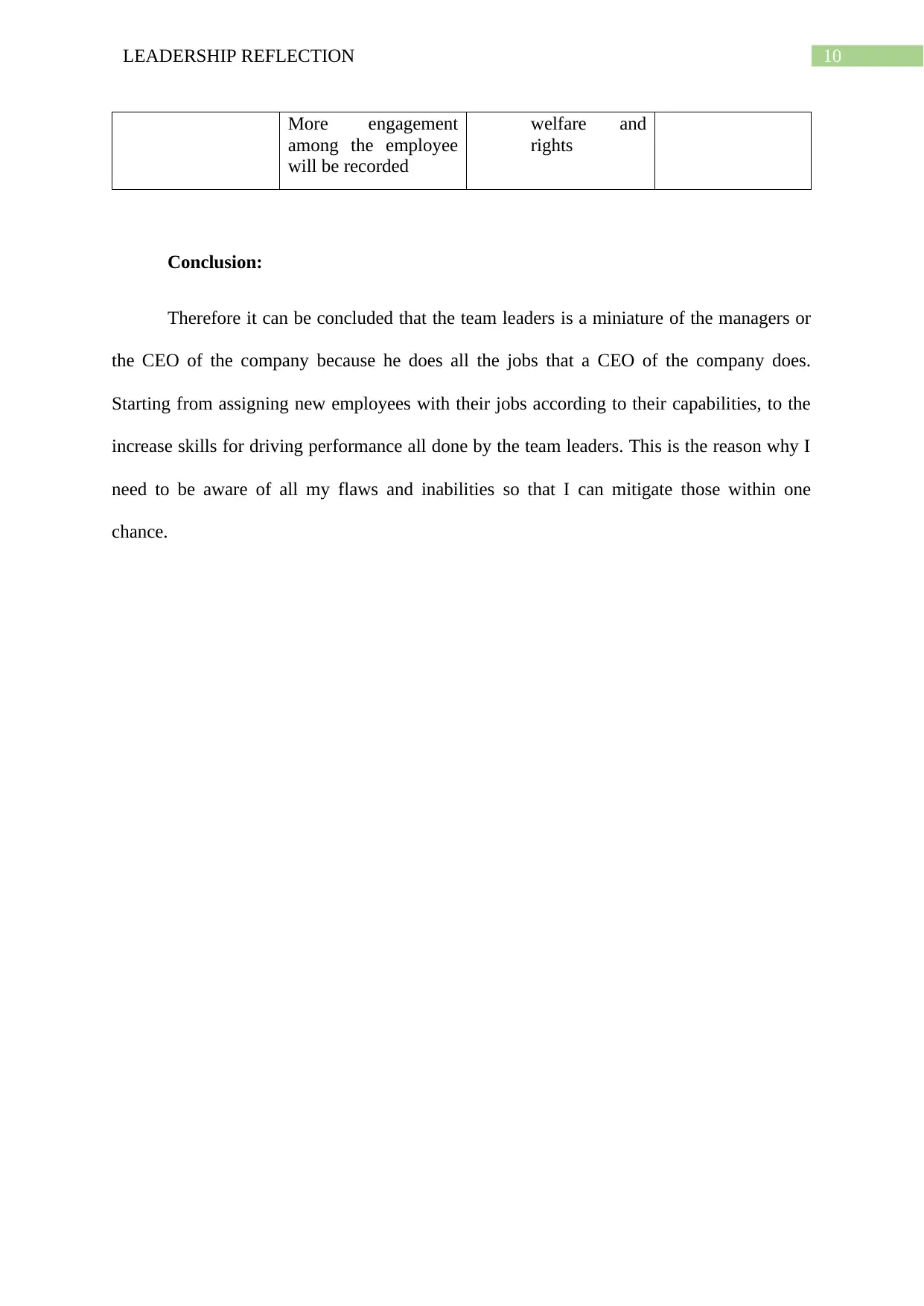
10LEADERSHIP REFLECTION
More engagement
among the employee
will be recorded
welfare and
rights
Conclusion:
Therefore it can be concluded that the team leaders is a miniature of the managers or
the CEO of the company because he does all the jobs that a CEO of the company does.
Starting from assigning new employees with their jobs according to their capabilities, to the
increase skills for driving performance all done by the team leaders. This is the reason why I
need to be aware of all my flaws and inabilities so that I can mitigate those within one
chance.
More engagement
among the employee
will be recorded
welfare and
rights
Conclusion:
Therefore it can be concluded that the team leaders is a miniature of the managers or
the CEO of the company because he does all the jobs that a CEO of the company does.
Starting from assigning new employees with their jobs according to their capabilities, to the
increase skills for driving performance all done by the team leaders. This is the reason why I
need to be aware of all my flaws and inabilities so that I can mitigate those within one
chance.
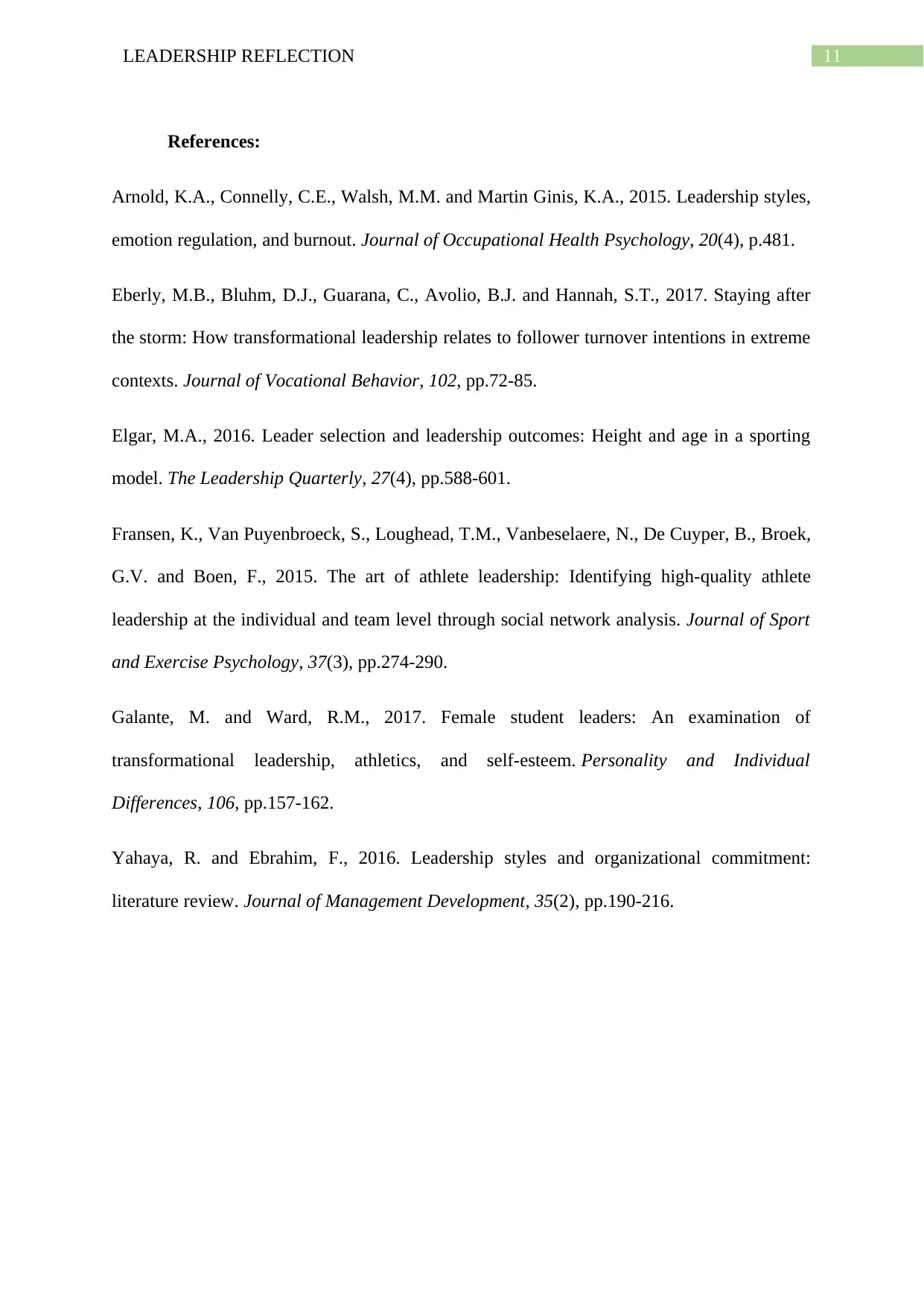
11LEADERSHIP REFLECTION
References:
Arnold, K.A., Connelly, C.E., Walsh, M.M. and Martin Ginis, K.A., 2015. Leadership styles,
emotion regulation, and burnout. Journal of Occupational Health Psychology, 20(4), p.481.
Eberly, M.B., Bluhm, D.J., Guarana, C., Avolio, B.J. and Hannah, S.T., 2017. Staying after
the storm: How transformational leadership relates to follower turnover intentions in extreme
contexts. Journal of Vocational Behavior, 102, pp.72-85.
Elgar, M.A., 2016. Leader selection and leadership outcomes: Height and age in a sporting
model. The Leadership Quarterly, 27(4), pp.588-601.
Fransen, K., Van Puyenbroeck, S., Loughead, T.M., Vanbeselaere, N., De Cuyper, B., Broek,
G.V. and Boen, F., 2015. The art of athlete leadership: Identifying high-quality athlete
leadership at the individual and team level through social network analysis. Journal of Sport
and Exercise Psychology, 37(3), pp.274-290.
Galante, M. and Ward, R.M., 2017. Female student leaders: An examination of
transformational leadership, athletics, and self-esteem. Personality and Individual
Differences, 106, pp.157-162.
Yahaya, R. and Ebrahim, F., 2016. Leadership styles and organizational commitment:
literature review. Journal of Management Development, 35(2), pp.190-216.
References:
Arnold, K.A., Connelly, C.E., Walsh, M.M. and Martin Ginis, K.A., 2015. Leadership styles,
emotion regulation, and burnout. Journal of Occupational Health Psychology, 20(4), p.481.
Eberly, M.B., Bluhm, D.J., Guarana, C., Avolio, B.J. and Hannah, S.T., 2017. Staying after
the storm: How transformational leadership relates to follower turnover intentions in extreme
contexts. Journal of Vocational Behavior, 102, pp.72-85.
Elgar, M.A., 2016. Leader selection and leadership outcomes: Height and age in a sporting
model. The Leadership Quarterly, 27(4), pp.588-601.
Fransen, K., Van Puyenbroeck, S., Loughead, T.M., Vanbeselaere, N., De Cuyper, B., Broek,
G.V. and Boen, F., 2015. The art of athlete leadership: Identifying high-quality athlete
leadership at the individual and team level through social network analysis. Journal of Sport
and Exercise Psychology, 37(3), pp.274-290.
Galante, M. and Ward, R.M., 2017. Female student leaders: An examination of
transformational leadership, athletics, and self-esteem. Personality and Individual
Differences, 106, pp.157-162.
Yahaya, R. and Ebrahim, F., 2016. Leadership styles and organizational commitment:
literature review. Journal of Management Development, 35(2), pp.190-216.
⊘ This is a preview!⊘
Do you want full access?
Subscribe today to unlock all pages.

Trusted by 1+ million students worldwide
1 out of 12
Related Documents
Your All-in-One AI-Powered Toolkit for Academic Success.
+13062052269
info@desklib.com
Available 24*7 on WhatsApp / Email
![[object Object]](/_next/static/media/star-bottom.7253800d.svg)
Unlock your academic potential
Copyright © 2020–2025 A2Z Services. All Rights Reserved. Developed and managed by ZUCOL.





